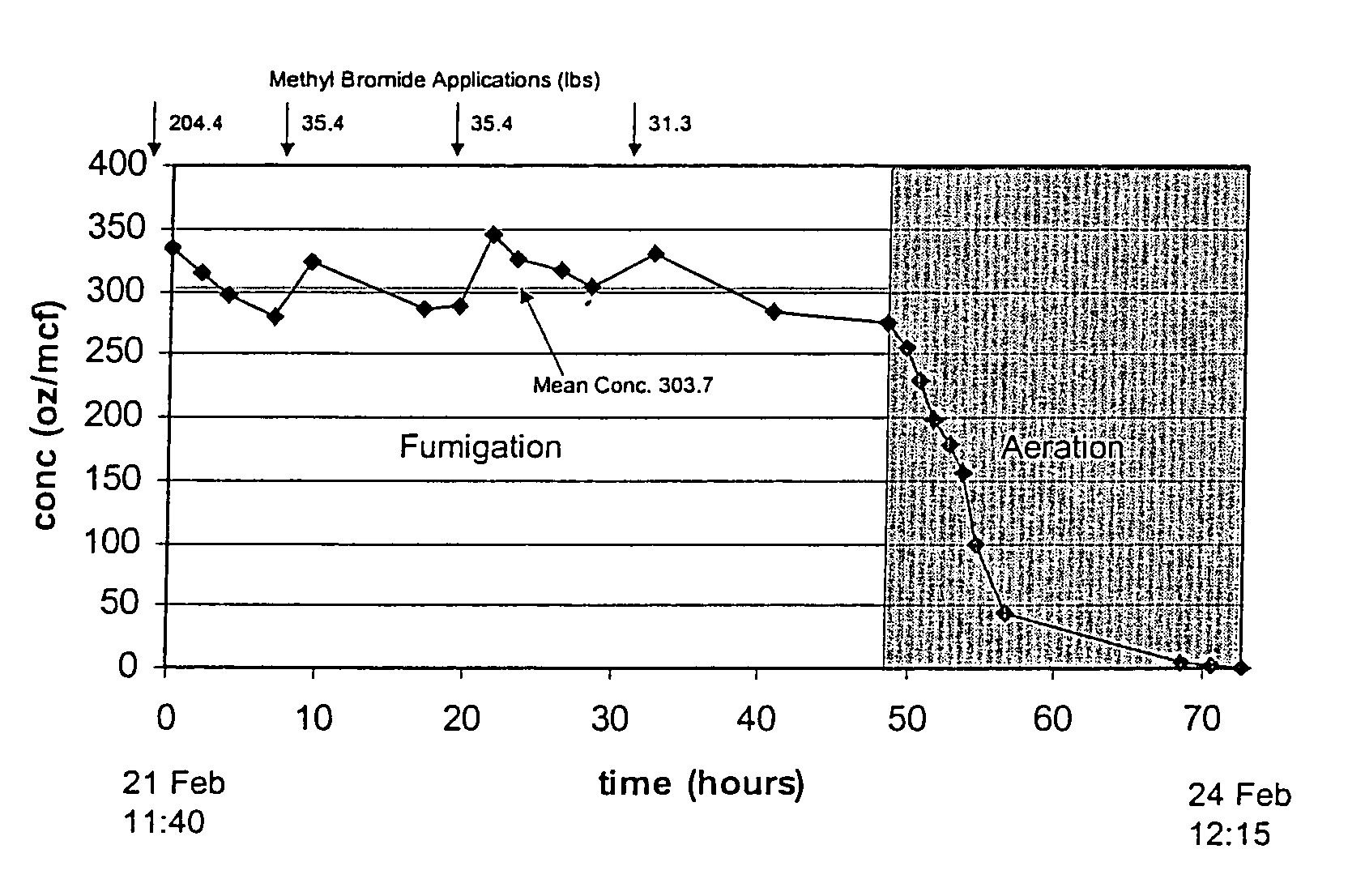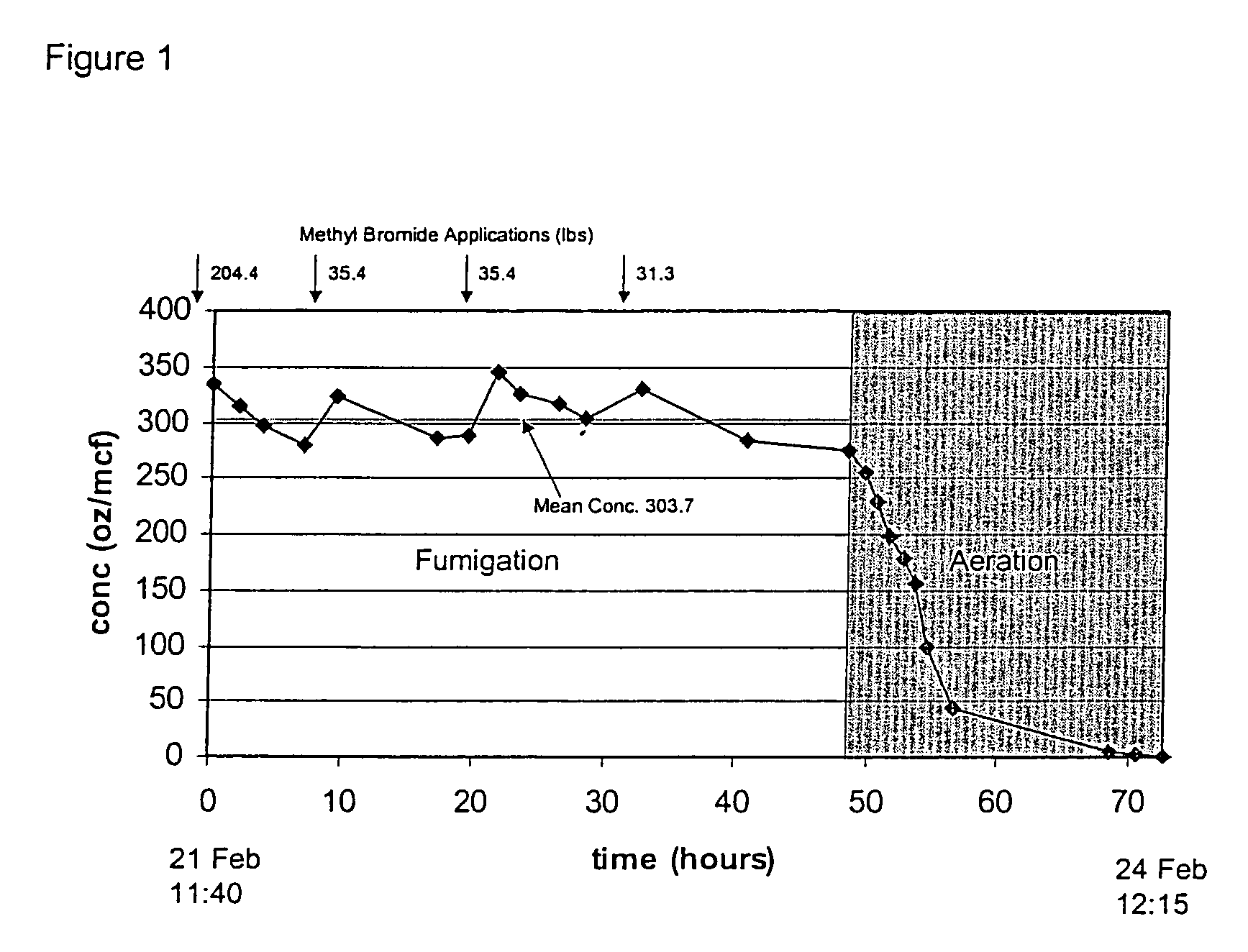Method of decontamination of whole structures and articles contaminated by pathogenic spores
a technology of pathogenic spores and whole structures, which is applied in the direction of disinfection, chemical/physical/physicochemical processes, chemical apparatuses and processes, etc., can solve the problems of methyl bromide and other known structural fumigants, which have never been used, and have never been used in the decontamination of human pathogens' structures. , to achieve the effect of non-flammability
- Summary
- Abstract
- Description
- Claims
- Application Information
AI Technical Summary
Benefits of technology
Problems solved by technology
Method used
Image
Examples
example 1
Spore Strips
[0043]The University of Florida Sterilization Monitoring and Consulting Service, Dept. of Oral & Maxillofacial Surgery, Gainesville, Fla., provided combined species spores strips that contained 106 spores of B. subtilis var. niger strips derived from ATCC #9372, and 105 spores of B. stearothermophilus derived from ATCC #7953. The spore strips were in Schleicher & Schuell filter paper (#470, 6.4×38.1 mm) packaged in a Glassine® paper pouch. Glassine paper is permeable to sterilant but resistant to moisture and air at ambient temperature / pressure. These strips are standard indicators for verifying the efficacy of chemical, dry-heat, and steam sterilization equipment. After the methyl bromide exposures, the strips were incubated in tryptic soy broth as recommended by the strip manufacturer. At 48 hours, color change of the broth from purple to yellow indicates spore germination and vegetative growth of the Bacillus . If broth color does not change, the spores are not viable...
example 2
[0048]The same materials and experiment conditions of Example 1 were used in the Example 2, except the incubation temperatures and the concentrations of methyl bromide in the chambers. The incubation temperatures were raised up to 27° C. Methyl bromide concentration was raised up to 320 mg / l (theoretical value). Furthermore, because B. sterothermophilus spores showed to be more susceptible to methyl bromide than those of B. subtilis under the experimental conditions of Example 1, both strips in each chamber were incubated for B. subtilis in the experiment of Example 2.
[0049]In addition to spore strips, one chamber (320 mg / l methyl bromide, 27° C., 96 hrs) was fitted with a videotape, CD with data, ZIP diskette with data, calculator, AA battery, laser-printed document, disposable camera with partially exposed film, galvanized and stainless steel washers, and photographs (laser-jet and photo emulsion paper). Office commodity exposures were used to access the effect of methyl bromide o...
example 3
[0054]The same materials and experiment conditions of Example 2 were used in the Example 3, except that the incubation temperature was further elevated to 32° C.
[0055]The test results expressed as germination of Bacillus sp. spores after exposure to methyl bromide in 9-liter glass chambers under selected concentration, temperature, and time conditions are shown in Table 3.
[0056]As shown, when the exposure temperature was further raised to 32° C., with a methyl bromide concentration of 240 mg / l B. subtilis spore germination was successfully disabled, after exposure under such a condition for only 38 hours, which was almost only half of the time period required at 27° C. This experiment further illustrated the importance of temperature in inhibiting germination of B. subtilis spores.
[0057]
TABLE 3MeBrTempConc.TimeDosage.Spore Germination(° C.1)(mg / l2)(hours)(mg-hr / l)B. stearo.B. subtilis273204815,360nt3no273206219,776ntno321607211,520ntyes322404811,520ntno322407217,280ntno323203812,160...
PUM
| Property | Measurement | Unit |
|---|---|---|
| Temperature | aaaaa | aaaaa |
| Temperature | aaaaa | aaaaa |
| Temperature | aaaaa | aaaaa |
Abstract
Description
Claims
Application Information
 Login to View More
Login to View More - R&D
- Intellectual Property
- Life Sciences
- Materials
- Tech Scout
- Unparalleled Data Quality
- Higher Quality Content
- 60% Fewer Hallucinations
Browse by: Latest US Patents, China's latest patents, Technical Efficacy Thesaurus, Application Domain, Technology Topic, Popular Technical Reports.
© 2025 PatSnap. All rights reserved.Legal|Privacy policy|Modern Slavery Act Transparency Statement|Sitemap|About US| Contact US: help@patsnap.com


